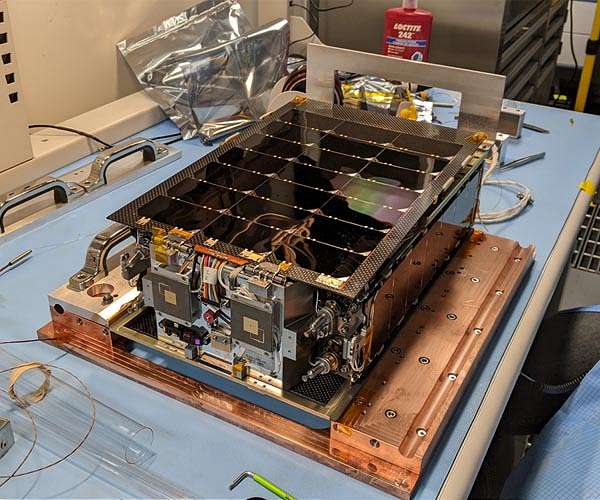
NASA Marshall Team Delivers Tiny, Powerful ‘Lunar Flashlight’ Propulsion System (Image Credit: Space Daily)
Engineers at NASA’s Marshall Space Flight Center in Huntsville, Alabama, have built some of the largest rocket engines ever to light up the icy reaches of space. Now Marshall and its commercial partners have delivered one of the smallest propulsion systems in its history, designed to help propel an upcoming NASA mission to shed new light on the Moon’s South Pole – in search of a much more useful type of ice.
Lunar Flashlight, no larger than a briefcase, is an innovative, low-cost CubeSat developed and managed by NASA’s Jet Propulsion Laboratory in Southern California. As the spacecraft orbits the Moon, its near-infrared lasers will shine light onto the permanently shadowed surface of the lunar pole, while its onboard reflectometer measures surface reflection and composition to identify large ice deposits.
Expected to launch later in 2022 via a SpaceX Falcon 9 rocket, Lunar Flashlight will seek out water ice on the lunar surface, which could be collected and purified for drinking water or converted into breathable oxygen or even into rocket fuel.
NASA is seeking lunar ice deposits to answer longtime questions about the composition, quantity, and distribution of frozen water on the Moon. The mission will help determine where it exists on the surface – and whether there is enough to sustain future lunar colonies and to power advanced lunar habitats and laboratories.
The Lunar Flashlight Propulsion System was fast-tracked for design, fabrication, and testing in July 2019. “We had to scale the propulsion technology down to something that could fit into a backpack, yet with all the same challenges of larger propulsion systems,” said Daniel Cavender, manager of the project at Marshall. “This was made easier by our strategic investments in small-satellite propulsion technologies over the past few years.”
Work also benefited from new partnerships with industry and academia. Marshall led the design of the compact propulsion system and oversaw hardware development in its in-house facilities and at Plasma Processes LLC of Huntsville and Flight Works of Irvine, California. Researchers at the Georgia Institute of Technology’s Space Systems Design Lab in Atlanta built the fuel tank and electrical controller and led system integration and testing.
The tiny craft is fueled with a chemical monopropellant – a fuel capable of burning by itself without a separate oxidizer – known as Advanced Spacecraft Energetic Non-Toxic, or ASCENT. Developed by the Air Force Research Laboratory and first tested on NASA’s Green Propellant Infusion Mission, which concluded in 2020, ASCENT is a “green,” low-toxic alternative to the conventional monopropellant hydrazine.
“CubeSats like this one are ideal tools to demonstrate new technology while enabling compelling science and exploration,” Cavender said. “They have a relatively short design lifecycle and modest cost, yet the science return can be huge.”
Beyond the obvious value of finding potable water for astronauts to drink, the ability to convert lunar water ice into hydrogen and oxygen – the basic requirements to make rocket fuel – could help establish a permanent fuel depot on the Moon, enabling lunar launches of future deep space missions to Mars and other destinations.
“The mission will demonstrate our ability to use powerful, compact propulsive CubeSats for a variety of science missions at the Moon and across the solar system,” Cavender said. “That’s a game-changing capability for exploration and planetary science.”
Marshall delivered the propulsion system to the Jet Propulsion Laboratory in May 2021 for spacecraft integration. Lunar Flashlight will return to Marshall for fueling before being transported to NASA’s Kennedy Space Center in Florida for launch as a secondary payload on the same rocket as Intuitive Machines’ first mission under NASA’s Commercial Lunar Payload Services initiative. Once launched, Lunar Flashlight will take roughly six months to reach the Moon, where it will achieve a polar orbit and begin its two-month primary mission.
Selected by NASA’s Artemis Campaign Development Division in 2014, the Lunar Flashlight CubeSat mission is funded by NASA’s Small Spacecraft Technology program, part of the agency’s Space Technology Mission Directorate, via a NASA Small Business Innovation Research grant. Dr. Barbara Cohen, a researcher at NASA’s Goddard Space Flight Center in Greenbelt, Maryland, is its measurement lead.
Related Links
Green Propellant Infusion Mission
Rocket Science News at Space-Travel.Com
|
|
Tweet |
|
|
|
We need your help. The SpaceDaily news network continues to grow but revenues have never been harder to maintain. With the rise of Ad Blockers, and Facebook – our traditional revenue sources via quality network advertising continues to decline. And unlike so many other news sites, we don’t have a paywall – with those annoying usernames and passwords. Our news coverage takes time and effort to publish 365 days a year. If you find our news sites informative and useful then please consider becoming a regular supporter or for now make a one off contribution. |
||
|
SpaceDaily Monthly Supporter $5+ Billed Monthly |
SpaceDaily Contributor $5 Billed Once credit card or paypal |
|
NASA rolls SLS moon rocket back out to Kennedy Space Center launch pad
Washington DC (UPI) Jun 07, 2022
NASA’s Space Launch System moon rocket reached the launching pad at Kenndy Space Center in Florida Monday morning after its slow-rolling 4.2-mile hike.
The trip to the historic 39B launch pad, which finished up around 8:20 a.m. EDT, will allow the rocket to be loaded with super-cold propellants as it prepares for launch around the moon later this summer.
The crew will conduct what is called a “wet dress rehearsal,” where the launch team will go through opera … read more









